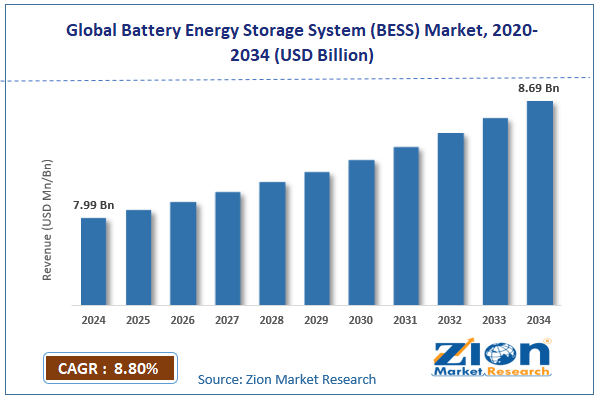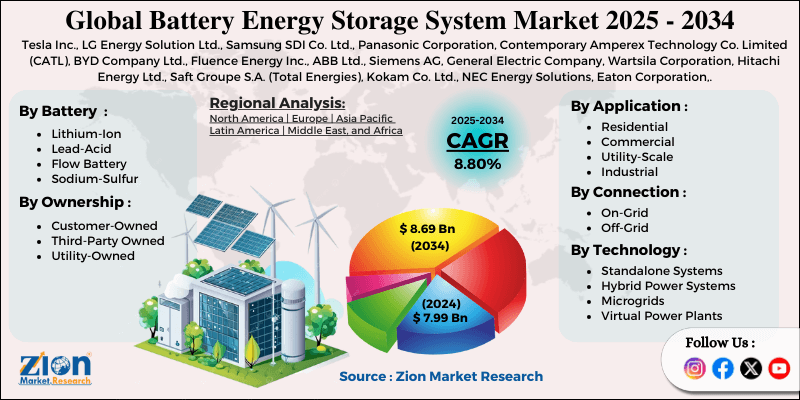Battery Energy Storage System (BESS) Market Size, Share, Trends, Growth and Forecast 2034

Battery Energy Storage System (BESS) Market By Battery Type (Lithium-Ion, Lead-Acid, Flow Battery, and Sodium-Sulfur), By Connection Type (On-Grid and Off-Grid), By Ownership (Customer-Owned, Third-Party Owned, and Utility-Owned), By Application (Residential, Commercial, Utility-Scale, and Industrial), By Technology Integration (Standalone Systems, Hybrid Power Systems, Microgrids, and Virtual Power Plants), and By Region - Global and Regional Industry Overview, Market Intelligence, Comprehensive Analysis, Historical Data, and Forecasts 2025 - 2034
| Market Size in 2024 | Market Forecast in 2034 | CAGR (in %) | Base Year |
|---|---|---|---|
| USD 7.99 Billion | USD 8.69 Billion | 8.80% | 2024 |
Battery Energy Storage System (BESS) Industry Prospective:
The global battery energy storage system (BESS) market size was valued at approximately USD 7.99 billion in 2024 and is expected to reach around USD 8.69 billion by 2034, growing at a compound annual growth rate (CAGR) of roughly 8.80% between 2025 and 2034.
Battery Energy Storage System (BESS) Market: Overview
Battery energy storage systems (BESS) encompass energy storage technologies, power management components, control systems, thermal regulation equipment, and grid interface solutions that enable organizations to store electrical energy for later utilization. This allows grid stability, renewable integration, peak demand management, and energy independence across multiple applications.
BESS has changed many industries through increased energy flexibility, reliability optimization, and power quality improvement. Battery energy storage systems are the foundation of the modern energy transition, providing capacity reserves, frequency regulation, renewable smoothing, and outage resilience so entities can ride through changing energy demands while staying stable. Expanding renewable deployment, grid modernization initiatives, and evolving power quality requirements drive the BESS market.
Over the forecast period, accelerating renewable integration, expanded microgrid deployments, evolving utility-scale implementations, and residential adoption across various geographical regions will drive the market.
Key Insights:
- As per the analysis shared by our research analyst, the global battery energy storage system market is estimated to grow annually at a CAGR of around 8.80% over the forecast period (2025-2034)
- In terms of revenue, the global battery energy storage system market size was valued at around USD 7.99 billion in 2024 and is projected to reach USD 8.69 billion by 2034.
- The battery energy storage system market is projected to grow significantly due to increasing renewable energy integration requirements, rising grid reliability concerns, growth in energy time-shifting applications requiring substantial storage capacity, and expanding distributed energy resources across utility networks.
- Based on the battery type, lithium-ion technologies lead the segment and will continue to dominate the global market.
- Based on connection type, on-grid systems are anticipated to command the largest market share by the end of the forecast period.
- Based on ownership, utility-owned systems are expected to lead the market during the forecast period.
- Based on application, utility-scale implementations will remain dominant during the forecast period.
- Based on technology integration, hybrid power systems will dominate the global market during the forecast period.
- Based on region, Asia Pacific is projected to dominate the global market during the forecast period.
Battery Energy Storage System Market: Growth Drivers
Rising renewable integration and grid stabilization requirements
With renewable energy growth in the battery energy storage system market, solutions are focused on providing better grid support. Utilities are looking for BESS that offers frequency regulation, renewable smoothing, and demand response to help manage intermittency.
According to recent industry surveys, energy companies invest more in storage infrastructure, and renewable-related integration applications have grown significantly. Grid operator requirements for stabilization resources and optimized power quality management drive the market.
Energy independence and resilience enhancement
Technology is advancing the battery energy storage system industry, with manufacturers adding features like modular architecture, rapid response, and advanced battery management systems. Modern BESS solutions provide better operational flexibility, backup power, and energy security. Resilience drives new BESS implementations, and blackout protection is one of the top three required features. Advanced thermal management and optimized control algorithms contribute to performance and longer lifespan.
Battery Energy Storage System Market: Restraints
Initial investment requirements and extended payback periods
Capital expenditure concerns, financing limitations, and return-on-investment timeframes represent significant obstacles in the battery energy storage system market. Developers must address the economics as the technology is deployed across different segments. According to industry reports, utilities say financial barriers are the biggest challenge to market adoption, especially for systems requiring huge upfront investment without immediate revenue generation.
Battery Energy Storage System Market: Opportunities
Integration of advanced battery chemistries and digital optimization platforms
Next-generation energy storage technologies and enhanced management capabilities are transforming the battery energy storage system market by delivering superior energy density, improved cycling performance, and alignment with sustainability objectives. Digitally optimized battery energy storage systems can perform predictive maintenance beyond monitoring and performance optimization, and lower operational costs.
Battery Energy Storage System Market: Challenges
Regulatory uncertainty and permitting complexity
The battery energy storage system industry is moving forward, but policy variability and approval processes are significant barriers to growth. Developers say inconsistent regulations are the number one factor impacting project timelines. Permitting complexity and interconnection challenges make creating a clear development pathway hard. Different regions have different safety standards that affect installation protocols and commissioning processes. As companies embark on energy transition initiatives, demand for standardized, streamlined BESS regulatory frameworks balancing safety and deployment efficiency will increase.
Battery Energy Storage System (BESS) Market: Report Scope
| Report Attributes | Report Details |
|---|---|
| Report Name | Battery Energy Storage System (BESS) Market |
| Market Size in 2024 | USD 7.99 Billion |
| Market Forecast in 2034 | USD 8.69 Billion |
| Growth Rate | CAGR of 8.80% |
| Number of Pages | 212 |
| Key Companies Covered | Tesla Inc., LG Energy Solution Ltd., Samsung SDI Co. Ltd., Panasonic Corporation, Contemporary Amperex Technology Co. Limited (CATL), BYD Company Ltd., Fluence Energy Inc., ABB Ltd., Siemens AG, General Electric Company, Wartsila Corporation, Hitachi Energy Ltd., Saft Groupe S.A. (Total Energies), Kokam Co. Ltd., NEC Energy Solutions, Eaton Corporation, Lockheed Martin Corporation, Toshiba Corporation, Honeywell International Inc., Enphase Energy, and others. |
| Segments Covered | By Battery Type, By Connection Type, By Ownership, By Application, By Technology Integration, and By Region |
| Regions Covered | North America, Europe, Asia Pacific (APAC), Latin America, Middle East, and Africa (MEA) |
| Base Year | 2024 |
| Historical Year | 2019 to 2023 |
| Forecast Year | 2025 - 2034 |
| Customization Scope | Avail customized purchase options to meet your exact research needs. Request For Customization |
Battery Energy Storage System Market: Segmentation
The global battery energy storage system market is segmented into battery type, connection type, ownership, application, technology integration, and region.
Based on battery type, the market is segregated into lithium-ion, lead-acid, flow battery, and sodium-sulfur. Lithium-ion solutions lead the market by offering superior energy density characteristics, operational efficiency advantages, and declining cost trajectories.
Based on connection type, the battery energy storage system industry is classified into on-grid and off-grid. On-grid systems are expected to lead the market during the forecast period, as these implementations provide grid support capabilities, peak shaving functionality, and energy arbitrage opportunities that enhance utility operations.
Based on ownership, the battery energy storage system industry is categorized into customer-owned, third-party-owned, and utility-owned. Utility-owned systems are expected to lead the market since they enable grid-scale implementation and systematic integration with existing infrastructure.
Based on application, the industry is segregated into residential, commercial, utility-scale, and industrial. Utility-scale applications lead the market due to the widespread adoption of grid stabilization solutions, renewable integration requirements, and transmission congestion management needs.
Based on technology integration, the battery energy storage system market is divided into standalone systems, hybrid power systems, microgrids, and virtual power plants. Hybrid power systems are expected to dominate the market by establishing effective frameworks for renewable integration and reliability enhancement across multiple scales.
Battery Energy Storage System Market: Regional Analysis
Asia Pacific to lead the market
Asia Pacific leads the global battery energy storage system market, racing ahead with renewable energy deployment, massive grid modernization investments, and comprehensive energy transition plans across China, Japan, and South Korea. China accounts for 35% of global BESS deployment, as storage is deeply embedded in national energy policies and infrastructure development. The region has massive manufacturing capabilities and tech development resources, establishing production leadership and advancing specialized energy storage technologies.
Big battery makers like CATL, LG Energy Solution, and Samsung SDI have significant regional presence and implementation partnerships to drive innovation and broad deployment. Energy companies in Asia Pacific allocate more of their infrastructure budget to storage technologies than their global peers, making the energy transition sector boom. The region has a supportive policy environment for renewable integration technologies, driving the market. Strong manufacturing ecosystems and fast cost-reduction trends drive BESS adoption across all applications.
Plus, grid-interactive systems, renewable-paired installations, and distributed energy resources are being implemented to enhance resilience and operational flexibility. Utilities require more grid stabilization and power quality management, which is driving energy companies to deploy advanced storage solutions and making reliability enhancement and operational efficiency more critical.
North America is set to grow significantly.
North America is growing rapidly in the battery energy storage system industry, driven by evolving regulatory frameworks, grid resilience concerns, and utility business model transformation. The US and Canada are implementing policies and expanding the market for performance-based storage. Western states have witnessed 31% annual growth in utility-scale BESS implementation within regional grid networks.
The region is focused on reliability and renewable integration, so solutions combining performance optimization and regulatory compliance are emerging, especially in areas with existing renewable generation.
Additionally, increasing state-level clean energy mandates, rising grid security priorities, and advancements in control system architecture are accelerating the adoption of advanced battery energy storage systems.
Recent Market Developments:
- In January 2025, Tesla Energy expanded its Megapack platform with the Advanced Grid Services Suite and Virtual Power Plant Integration, addressing the complex balancing requirements of renewable-dominated grids.
- In February 2025, Fluence introduced the all-new GridStack XL, a comprehensive utility-scale storage solution with AI-powered dispatch optimization capabilities, establishing new standards for grid support services.
Battery Energy Storage System Market: Competitive Analysis
The global battery energy storage system market is led by companies such as
- Tesla Inc.
- LG Energy Solution Ltd.
- Samsung SDI Co. Ltd.
- Panasonic Corporation
- Contemporary Amperex Technology Co. Limited (CATL)
- BYD Company Ltd.
- Fluence Energy Inc.
- ABB Ltd.
- Siemens AG
- General Electric Company
- Wartsila Corporation
- Hitachi Energy Ltd.
- Saft Groupe S.A. (Total Energies)
- Kokam Co. Ltd.
- NEC Energy Solutions
- Eaton Corporation
- Lockheed Martin Corporation
- Toshiba Corporation
- Honeywell International Inc.
- Enphase Energy
The global battery energy storage system market is segmented as follows:
By Battery Type
- Lithium-Ion
- Lead-Acid
- Flow Battery
- Sodium-Sulfur
By Connection Type
- On-Grid
- Off-Grid
By Ownership
- Customer-Owned
- Third-Party Owned
- Utility-Owned
By Application
- Residential
- Commercial
- Utility-Scale
- Industrial
By Technology Integration
- Standalone Systems
- Hybrid Power Systems
- Microgrids
- Virtual Power Plants
By Region
-
North America
- The U.S.
- Canada
- Europe
- France
- The UK
- Spain
- Germany
- Italy
- Rest of Europe
- Asia Pacific
- China
- Japan
- India
- South Korea
- Southeast Asia
- Rest of Asia Pacific
- Latin America
- Brazil
- Mexico
- Rest of Latin America
- Middle East & Africa
- GCC
- South Africa
- Rest of Middle East & Africa
Table Of Content
Methodology
FrequentlyAsked Questions
Battery energy storage systems encompass energy storage technologies, power management components, control systems, thermal regulation equipment, and grid interface solutions that enable organizations to store electrical energy for later utilization.
The battery energy storage system market is expected to be driven by increasing renewable energy integration requirements, rising grid reliability concerns, technological advancements enabling cost reduction, expanding distributed energy resources, and growing energy independence priorities driving resilience solutions.
According to our study, the global battery energy storage system market was worth around USD 7.99 billion in 2024 and is predicted to grow to around USD 8.69 billion by 2034.
The CAGR value of the battery energy storage system market is expected to be around 8.80% during 2025-2034.
The global battery energy storage system market will register the highest growth in Asia Pacific during the forecast period.
Key players in the battery energy storage system market include Tesla Inc., LG Energy Solution Ltd., Samsung SDI Co. Ltd., Panasonic Corporation, Contemporary Amperex Technology Co. Limited (CATL), BYD Company Ltd., Fluence Energy Inc., ABB Ltd., Siemens AG, General Electric Company, Wartsila Corporation, Hitachi Energy Ltd., Saft Groupe S.A. (Total Energies), Kokam Co. Ltd., NEC Energy Solutions, Eaton Corporation, Lockheed Martin Corporation, Toshiba Corporation, Honeywell International Inc., and Enphase Energy.
The report comprehensively analyzes the battery energy storage system market, including an in-depth discussion of market drivers, restraints, emerging trends, regional dynamics, and future growth opportunities. It also examines competitive dynamics, technological innovations, the evolving landscape of storage technologies, implementation challenges, and regulatory requirements shaping the BESS ecosystem.
Choose License Type
List of Contents
Industry Prospective:OverviewKey Insights:Battery Energy Storage System Growth DriversBattery Energy Storage System RestraintsBattery Energy Storage System OpportunitiesBattery Energy Storage System ChallengesReport ScopeBattery Energy Storage System SegmentationBattery Energy Storage System Regional AnalysisRecent Market Developments:Battery Energy Storage System Competitive AnalysisHappyClients
Zion Market Research
Tel: +1 (302) 444-0166
USA/Canada Toll Free No.+1 (855) 465-4651
3rd Floor,
Mrunal Paradise, Opp Maharaja Hotel,
Pimple Gurav, Pune 411061,
Maharashtra, India
Phone No +91 7768 006 007, +91 7768 006 008
US OFFICE NO +1 (302) 444-0166
US/CAN TOLL FREE +1 (855) 465-4651
Email: sales@zionmarketresearch.com
We have secured system to process your transaction.
Our support available to help you 24 hours a day, five days a week.
Monday - Friday: 9AM - 6PM
Saturday - Sunday: Closed







